Martin Chuzzlewit
The Life and Adventures of Martin Chuzzlewit (commonly known as Martin Chuzzlewit) is a novel by Charles Dickens, considered the last of his picaresque novels. It was originally serialised between 1842 and 1844. While he was writing it Dickens told a friend that he thought it was his best work,[1] but it was one of his least popular novels.[2] The late nineteenth century English novelist George Gissing read the novel in February 1888 "for refreshment" but felt that it showed "incomprehensible weakness of story".[3] Like nearly all of Dickens's novels, Martin Chuzzlewit was first published in monthly instalments. Early sales of the monthly parts were disappointing, compared to previous works, so Dickens changed the plot to send the title character to the United States.[4] This allowed the author to portray the United States, which he had visited in 1842, satirically, as a near-wilderness with pockets of civilisation filled with deceitful and self-promoting hucksters.
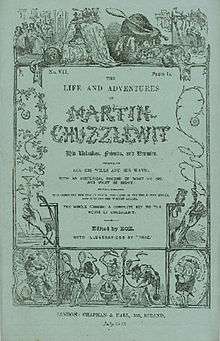 Cover of serial edition seventh instalment, July 1843 | |
| Author | Charles Dickens |
|---|---|
| Original title | The Life and Adventures of Martin Chuzzlewit |
| Illustrator | Hablot Knight Browne (Phiz) |
| Country | England |
| Language | English |
| Genre | Novel |
| Published | Serialised: 31 December 1842 – July 1844; as a book 1844 |
| Publisher | Chapman & Hall |
| Media type | Print (Serial, Hardback, and Paperback) |
| Preceded by | Barnaby Rudge |
| Followed by | Dombey and Son |
The main theme of the novel, according to Dickens's preface, is selfishness, portrayed in a satirical fashion using all the members of the Chuzzlewit family. The novel is also notable for two of Dickens's great villains, Seth Pecksniff and Jonas Chuzzlewit. It is dedicated to Angela Georgina Burdett-Coutts, a friend of Dickens's.
Plot summary
Martin Chuzzlewit has been raised by his grandfather and namesake. Years before Martin senior took the precaution of raising an orphaned girl, Mary Graham, to be his nursemaid, with the understanding that she will be well cared for only as long as Martin senior lives. She thus has a strong motive to promote his well-being, in contrast to his relatives, who want to inherit his money. However, his grandson Martin falls in love with Mary and wishes to marry her, ruining Martin senior's plans. When Martin refuses to give up the engagement his grandfather disinherits him.
Martin becomes an apprentice to Seth Pecksniff, a greedy architect. Instead of teaching his students he lives off their tuition fees and has them do draughting work that he passes off as his own. He has two spoiled daughters, Charity and Mercy, nicknamed Cherry and Merry. Unbeknown to Martin, Pecksniff has taken him on in order to establish closer ties with his wealthy grandfather.
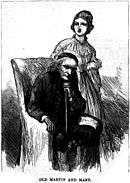
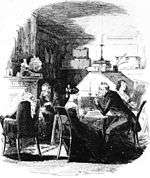
Young Martin befriends Tom Pinch, a kind-hearted soul whose late grandmother gave Pecksniff all she had in the belief that Pecksniff would make an architect and a gentleman of him. Pinch is incapable of believing any of the bad things others tell him of Pecksniff, and always defends him vociferously. Pinch works for exploitatively low wages while believing that he is the unworthy recipient of Pecksniff's charity.
When Martin senior hears of his grandson's new life he demands that Pecksniff kick young Martin out. Then Martin senior moves in and falls under Pecksniff's control. During this time Pinch falls in love with Mary, but does not declare his feelings, knowing of her attachment to young Martin.
One of Martin senior's greedy relatives is his brother, Anthony Chuzzlewit, who is in business with his son, Jonas. Despite their considerable wealth, they live miserly, cruel lives. Jonas, eager for the old man to die so that he can inherit, constantly berates his father. Anthony dies abruptly and under suspicious circumstances, leaving his wealth to Jonas. Jonas then woos Cherry, while arguing constantly with Merry. He then abruptly declares to Pecksniff that he wants to marry Merry and jilts Cherry, not without demanding an additional £1,000 on top of the £4,000 that Pecksniff has promised him as Cherry's dowry, with the argument that Cherry has better chances for matchmaking.
Jonas, meanwhile, becomes entangled with the unscrupulous Montague Tigg, formerly a petty thief and hanger-on of a Chuzzlewit relative, Chevy Slyme, and joins in Tigg's crooked insurance business. Tigg cheats young Martin out of a valuable pocket watch and uses the funds to transform himself into a seemingly fine man, calling himself "Tigg Montague". This convinces investors that he must be an important businessman from whom they may greatly profit. Jonas eventually ends up murdering Tigg, who has acquired embarrassing information about him.
At this time Tom Pinch sees his employer's true character, goes to London to seek new employment, and rescues his sister Ruth from mistreatment by the family that employs her as a governess. Pinch quickly receives an ideal job from a mysterious employer with the help of an equally mysterious Mr Fips.
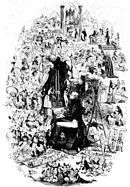
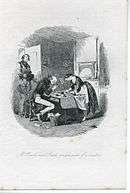
Young Martin, meanwhile, has encountered Mark Tapley, who is always cheerful, which he decides does not reflect well on him because it shows no strength of character to be happy when one has good fortune. Mark decides that he must test his cheerfulness by seeing if he can maintain it in the worst possible circumstances. To this end he accompanies young Martin when he goes to the United States to seek his fortune. The two men attempt to start new lives in a swampy, disease-filled settlement named Eden, but both nearly die of malaria. Mark finally finds himself in a situation in which it can be considered a virtue to remain in good spirits. The grim experience, and Mark's nursing of Martin back to health, change Martin's selfish and proud character, and the men return to England, where Martin seeks reconciliation with his grandfather. By this time, however, his grandfather is under Pecksniff's control and rejects him.
Martin is then reunited with Tom Pinch. They discover that Tom's mysterious benefactor is old Martin Chuzzlewit, who has been pretending to be in thrall to Pecksniff. Together the group confront Pecksniff with their knowledge of his true character. They also discover that Jonas has murdered Tigg to prevent him from revealing that he had planned to murder Anthony.
Martin senior reveals that he was angry at his grandson for becoming engaged to Mary because he had planned to arrange that particular match himself, and felt that his glory had been thwarted by their action. Martin and his grandfather are reconciled, and Martin and Mary are married, as are Ruth Pinch and John Westlock, another former student of Pecksniff's. Tom Pinch remains in unrequited love with Mary for the rest of his life, never marrying, and always being a warm companion to Mary, Martin, Ruth and John.
Characters
Extended Chuzzlewit family
The main characters of the story are the members of the extended Chuzzlewit family.
The first to be introduced is Seth Pecksniff, a widower with two daughters, who is a self-styled teacher of architecture. He believes that he is a highly moral individual who loves his fellow man, but he mistreats his students and passes off their designs as his own for profit. He is said to be a cousin of old Martin Chuzzlewit. Pecksniff's rise and fall follows the novel's plot arc.
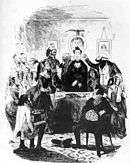
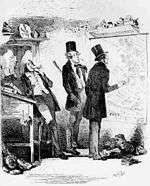
Next we meet his two daughters, Charity and Mercy Pecksniff. They are also affectionately known as Cherry and Merry, or as the two Miss Pecksniffs. Charity is portrayed throughout the book as having none of that virtue after which she is named, while Mercy, the younger sister, is at first silly and girlish, though later events drastically change her personality.
Old Martin Chuzzlewit, the wealthy patriarch of the Chuzzlewit family, lives in constant suspicion of the financial designs of his extended family. At the beginning of the novel he has aligned himself with Mary, an orphan, to have a caretaker who is not expecting a share of his estate. Later in the story he makes an apparent alliance with Pecksniff, who, he believes, is at least consistent in character. His own true character is revealed by the end of the story.
Young Martin Chuzzlewit is the grandson of old Martin Chuzzlewit. He is the closest relative of old Martin, and has inherited much of the stubbornness and selfishness of the old man. Young Martin is the protagonist of the story. His engagement to Mary is the cause of estrangement between himself and his grandfather. By the end of the story he has become a reformed character, having realised and repented of the selfishness of his previous actions.
Anthony Chuzzlewit is the brother of old Martin. He and his son, Jonas, run a business called Chuzzlewit and Son. They are both self-serving, hardened individuals who view the accumulation of money as the most important thing in life.
Jonas Chuzzlewit is the mean-spirited, sinisterly jovial son of Anthony Chuzzlewit. He views his father with contempt and wishes for his death, so that he can have the business and the money for himself. It is suggested that he may have hastened the old man's death. He is a suitor of the two Miss Pecksniffs, wins one, then is driven to commit murder by his unscrupulous business associations.
Mr and Mrs Spottletoe are the nephew-in-law and niece of old Martin Chuzzlewit, Mrs Spottletoe being the daughter of old Martin's brother. She was also once the favourite of old Martin, but they have since fallen out.
George Chuzzlewit is a bachelor cousin of old Martin.
Other characters
Thomas (Tom) Pinch is a former student of Pecksniff's who has become his personal assistant. He is kind, simple and honest in everything he does, serving as a foil to Pecksniff. He carries in his heart an extreme loyalty and admiration for Pecksniff until he discovers Pecksniff's true nature through his treatment of Mary, whom Pinch has come to love. Because Tom Pinch plays such a large role in the story he is sometimes considered the novel's true protagonist.
Ruth Pinch is Tom Pinch's sister. She is sweet and good like her brother. At first she works as a governess to a wealthy family, but later she and Tom set up home together. She falls in love with, and marries, Tom's friend John Westlock.
Mark Tapley, the good-humoured employee of the Blue Dragon Inn and suitor of Mrs Lupin, the landlady of the inn, leaves to find work that might be more of a credit to his character: that is, work sufficiently miserable that his cheerfulness will be more of a credit to him. He eventually joins young Martin Chuzzlewit on his trip to the United States, where he finds at last a situation that requires the full extent of his innate cheerfulness. Martin buys a piece of land in a settlement called Eden, which is in the midst of a malarial swamp. Mark nurses Martin through illness and they eventually return to England.
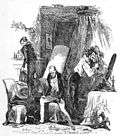
Montague Tigg / Tigg Montague is a down-on-his-luck rogue at the beginning of the story, and a hanger-on to a Chuzzlewit cousin named Chevy Slyme. Later Tigg starts the Anglo-Bengalee Disinterested Loan and Life Assurance Company, which pays off early policyholders' claims with premiums from more recent policyholders. Tigg lures Jonas into the business.
John Westlock begins as a disgruntled student falling out with Pecksniff. After Tom Pinch's flight to London John serves as a mentor and companion to both Tom and his sister. He falls in love with and eventually marries Ruth Pinch.
Mr Nadgett is a soft-spoken, mysterious individual who is Tom Pinch's landlord and serves as Montague's private investigator. He is hired to investigate the private lives of potential clients whom Montague hopes to defraud. It has been claimed that he is the first private investigator in fiction.[5]
Sarah Gamp (also known as Sairey or Mrs Gamp) is an alcoholic who works as a midwife, a monthly nurse and a layer-out of the dead. Even in a house of mourning Mrs Gamp manages to enjoy all the hospitality the house can afford, with little regard for the person she is there to minister to, and she is often much the worse for drink. She constantly refers to a Mrs Harris, who is "a phantom of Mrs Gamp's brain ... created for the express purpose of holding visionary dialogues with her on all manner of subjects, and invariably winding up with a compliment to the excellence of her nature". Mrs Gamp habitually carries with her a battered black umbrella: so popular with the Victorian public was the character that Gamp became a slang word for an umbrella in general. It is believed that the character was based on a real nurse described to Dickens by his friend Angela Burdett-Coutts.[6][7]
Mary Graham is the companion of old Martin Chuzzlewit, who has told her that she will receive nothing from him in his will. He expects that this will give Mary a strong interest in keeping him alive and well. Mary and old Martin Chuzzlewit's grandson fall in love, thus giving her an interest in the elder Chuzzlewit's death. The two lovers are separated by the events of the book, but are eventually reunited.
Mr Chuffey is Anthony Chuzzlewit's old clerk and lifelong companion.
Jefferson Brick is a war correspondent in The New York Rowdy Journal.
Bailey is a boy employed first by Mrs Todgers, then by the fraudster Montague Tigg, who laments him after he is reported to have suffered a fatal head injury in falling out of a cabriolet, though he eventually recovers.
Publication
Martin Chuzzlewit was published in 19 monthly instalments, each comprising 32 pages of text and two illustrations by Hablot K. "Phiz" Browne and costing one shilling. The last part was double-length.
- I – December 1842 (chapters 1–3)
- II – February 1843 (chapters 4–5)
- III – March 1843 (chapters 6–8)
- IV – April 1843 (chapters 9–10)
- V – May 1843 (chapters 11–12)
- VI – June 1843 (chapters 13–15)
- VII – July 1843 (chapters 16–17)
- VIII – August 1843 (chapters 18–20)
- IX – September 1843 (chapters 21–23)
- X – October 1843 (chapters 24–26)
- XI – November 1843 (chapters 27–29)
- XII – December 1843 (chapters 30–32)
- XIII – January 1844 (chapters 33–35)
- XIV – February 1844 (chapters 36–38)
- XV – March 1844 (chapters 39–41)
- XVI – April 1844 (chapters 42–44)
- XVII – May 1844 (chapters 45–47)
- XVIII – June 1844 (chapters 48–50)
- XIX-XX – July 1844 (chapters 51–54)
The early monthly numbers were not as successful as Dickens's previous work and sold about 20,000 copies each, as compared to 40,000 to 50,000 for the monthly numbers of the Pickwick Papers and Nicholas Nickleby, and 60,000 to 70,000 for the weekly issues of Barnaby Rudge and The Old Curiosity Shop. The lack of success of the novel caused a rift between Dickens and his publishers Chapman and Hall when they invoked a penalty clause in his contract requiring him to pay back money they had lent him to cover their costs.
Dickens's scathing satire of American modes and manners in the novel won him no friends on the other side of the Atlantic, where the instalments containing the offending chapters were greeted with a "frenzy of wrath". As a consequence Dickens received abusive mail and newspaper clippings from the United States.[8]
Anti-Americanism
The novel has been seen by some Americans as unfairly critical of the United States, although Dickens himself saw it as satire similar in spirit to his "attacks" on certain people and particular institutions back home in England, in novels such as Oliver Twist. Fraud is shown as a common event in the United States. Americans are satirically portrayed: they proclaim their equality and their love of freedom and egalitarianism at every opportunity, but when they have travelled to England they boastfully claim to have been received only by aristocrats. The United States is described as "so maimed and lame, so full of sores and ulcers, foul to the eye and almost hopeless to the sense, that her best friends turn from the loathsome creature with disgust". Dickens also attacks the institution of slavery in the United States in the following words: "Thus the stars wink upon the bloody stripes; and Liberty pulls down her cap upon her eyes, and owns oppression in its vilest aspect for her sister."[9]
According to an unverified account published in the Boston Bee, the negative portrayal of the United States in Martin Chuzzlewit caused one Englishman who read the novel to be so put off that he chose to drown himself upon realizing his ship would be putting in at New York.[10]
George L. Rives wrote that "It is perhaps not too much to say that the publication of Martin Chuzzlewit did more than almost any other one thing to drive the United States and England in the direction of war" (over the Oregon boundary dispute, which was eventually resolved via diplomacy rather than war).[11]
In 1868, Dickens returned to the US and at a banquet in his honor hosted by the press in New York City, delivering an after-dinner speech in which he acknowledged the positive transformation which the United States had undergone and apologized for his previous negative reaction on his visit decades before. Furthermore, he announced that he would have the speech appended to each future edition of American Notes and Martin Chuzzlewit, and the volumes have been emended as such in all successive publications.[12]
Adaptations
In 1844 the novel was adapted into a stage play at the Queen's Theatre, featuring Thomas Manders in drag as Sarah Gamp.[13]
A short film adaptation of the novel was released in 1912.[14]
The novel was adapted into a television miniseries of the same title in 1994, starring Paul Scofield and Pete Postlethwaite.[4]
In popular culture
Examples of references in other television productions include one in the 1956 film Our Miss Brooks (concluding the television and radio series of the same title). Miss Brooks is tutoring teenaged Gary Nolan and gives him the choice of reading and writing a book report on Martin Chuzzlewit, or simply writing an article for the school paper. In The Simpsons episode "Brother, Can You Spare Two Dimes?" Lisa Simpson lists it as one of the books that she would receive from the Greater Books of the Western Civilization. In the Doctor Who episode "The Unquiet Dead" The Doctor expresses his admiration for Dickens' works but criticises Martin Chuzzlewit, saying, "Mind you, for God's sake, the American bit in Martin Chuzzlewit, what's that about? Was that just padding? Or what? I mean, it's rubbish, that bit."
The CGI movie Barbie in a Christmas Carol features a snooty cat named Chuzzlewit who is the pet of Barbie's character Eden Starling. John Travolta's character quotes from the novel in A Love Song for Bobby Long.
The novel is featured prominently in Jasper Fforde's novel The Eyre Affair.
References
- Berard, Jane H. (2007). Dickens and Landscape Discourse. New York: Peter Lang. p. 3. ISBN 9780820450049. Retrieved 1 November 2017.
- Hardwick, Michael and Mary Hardwick. The Charles Dickens Encyclopedia. New York: Scribner, 1973.
- Coustillas, Pierre, ed. London and the Life of Literature in Late Victorian England: the Diary of George Gissing, Novelist. Brighton: Harvester Press, 1978, p.22.
- "Dickens on Screen: Martin Chuzzlewit". British Film Institute. Retrieved 19 January 2012.
Dickens is said to have proclaimed Martin Chuzzlewit his best work. When early public sales of its first monthly instalments proved disappointing, Dickens changed the plot to send Martin to America, drawing on his visit there in 1842.
- Mitzi Brunsdale, Gumshoes: A Dictionary of Fictional Detectives, Introduction, p.3. Also, LeRoy Lad Panek, Before Sherlock Holmes: How Magazines and Newspapers Invented the Detective. p.97
- Donald Hawes (2001), Who's Who in Dickens, Routledge, pp. 84–86, ISBN 978-0-415-26029-9
- Summers, Annette (1997), "Sairey Gamp: Generating Fact from Fiction", Nursing Inquiry, Blackwell Publishing Ltd, 4 (1): 14–8, doi:10.1111/j.1440-1800.1997.tb00132.x, PMID 9146274
- Pearson 1949, pp. 132–33.
- Pearson 1949: 129–29
- "Deplorable". The Sun (Baltimore, Maryland). 14 August 1843. p. 2. Retrieved 7 August 2014.
- Rives, George Lockhart (1913). "The United States and Mexico, 1821-1848, v2".
- “Characters at Dickens’s Reading”, April 25, 1868 Harpweek
- Malcolm Morley, 'Martin Chuzzlewit in the Theatre', The Dickensian Vol. 47 (Jan 1, 1951): 98
- Martin Chuzzlewit, silentera.com
Sources
- Bowen, John. Other Dickens: Pickwick to Chuzzlewit. Oxford: Oxford University Press, 2003.
- Jordan, John O. The Cambridge Companion to Charles Dickens. New York: Cambridge University Press, 2001.
- Pearson, Hesketh. Dickens. Methuen: London, 1949.
- Purchase Sean (2006). "'Speaking of Them as a Body': Dickens, Slavery and Martin Chuzzlewit". Critical Survey. 18 (1): 1–16. doi:10.3167/001115706780810735.
- Sulfridge Cynthia (1979). "Martin Chuzzlewit: Dickens's Prodigal and the Myth of the Wandering Son". Studies in the Novel. 11 (3): 318–325.
- Tambling, Jeremy. Lost in the American city: Dickens, James, and Kafka. New York: Palgrave, 2001.
External links
| Wikiquote has quotations related to: Martin Chuzzlewit |
| Wikisource has original text related to this article: |
| Wikimedia Commons has media related to Martin Chuzzlewit. |
- Online editions
- Martin Chuzzlewit at Internet Archive
- Martin Chuzzlewit at Project Gutenberg (plain text and HTML)
- Martin Chuzzlewit, available at University of Adelaide (HTML).
